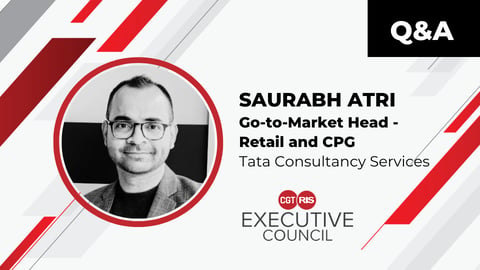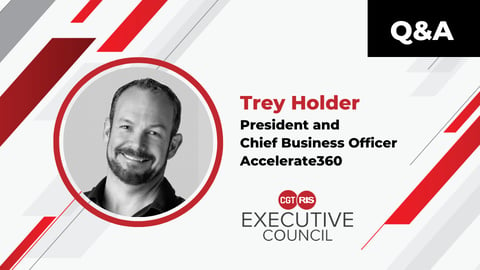Tapping Into Tech: An Inside Look With Google Cloud’s Carrie Tharp
Carrie Tharp’s retail journey began early on. She's currently the VP, retail and consumer at Google Cloud, but as a child, she was ringing the register at her family’s bakery store in Erie, Pennsylvania. Tharp nurtured those early experiences to create a longstanding commitment to the industry with one core belief always in mind: a positive customer experience while keeping consumers at a local level is the “very heart of retail.” Tharp’s career spans across e-commerce, digital experiences, and marketing, having worked with leading brands like Neiman Marcus Group, Fossil Group, Travelocity, and Dean Foods.
As a CGT/RIS Executive Council member, Tharp is a frequent contributor to our retail and CPG communities, and she recently shared her thoughts on some of today’s standout topics, including digitizing the store experience and the various emerging technologies brands can tap into to better engage with consumers.
CGT: Your background includes tenures at such retailers and brands as Neiman Marcus Group and Fossil. What are some of the ways you draw from this experience in your work with retailers and CPGs at Google Cloud?
After doing data-driven transformations one retailer at a time in my career, I joined Google Cloud to accelerate transformations in a scaled way across many companies by shaping the Google Cloud roadmap. I wanted to build the things that I always wanted Google to build for my teams when I was a retail leader.
EC Member Shares
How long have you been with Google Cloud?
More than 3 years
Which book is on your nightstand or to-do list?
Grit by Angela Duckworth
If you could have an unlimited supply of one thing for the rest of your life, what would it be?
Time. Life is all about prioritization, but more time to chase passions, spend time with family, explore new innovations — it can’t be beat by supply of any “thing” else.
Fill in the blank: "In 2023, I can't wait to…”
Check out all the new digital store experiences and personalization our customers are working on today!
I currently drive Google Cloud’s efforts to create data-driven, customer-centric strategies and solutions that drive growth through new customer experiences, digital innovation, and business model expansion. I draw from my digital knowledge and product and data/analytics experience to help shape our roadmap with practical experience in the trade-offs retailers are making to meet customer expectations and drive revenue and profit growth.
Understanding the challenges retail leaders are dealing with helps define not only what we build, but also how we design products and solutions that will be the most effective and efficient in retailers’ technology landscape. This allows me to bring the best of Google to our customers and their end customers in a rapidly evolving, channel-less environment.
CGT: Can you share any recent, perhaps unexpected, consumer behavior changes that CPGs and retailers should have on their radars?
Pre-pandemic, the retail and CPG environment was focused on omni-channel. At the time, 80% of transactions happening globally were in-store, but the shift to digital was continuous. COVID flipped the switch overnight. And although in-store shopping has resumed, the customer has changed forever.
Historically, only about 15% of customers would shop across multiple channels with a single retailer, but now consumers are really thinking channel-less. For instance, during the 2021 holiday shopping season, 54% of shoppers used five or more channels, like video and social media, to shop over a two-day period. In addition, consumers want to understand things like inventory availability before they head into the store. We’ve seen searches for “in stock” grow 800% YoY.
The need to break down channels isn’t a surprise to those in retail. However, new technologies and capabilities are now at the center of evolving these complex journeys. Artificial intelligence (AI), machine learning (ML), and predictive analytics are being used across many retail processes from demand forecasting to hyper personalization. Keeping pace with new technologies to meet customer expectations is a constant challenge and it’s becoming more difficult with time.
CGT: Where are you seeing true innovation when it comes to digitizing the retail store experience?
There’s so much potential in creating more real-time data streams from inside brick-and-mortar stores, similar to what already exists in e-commerce. Digitizing the store is not just in what a customer can see, but in how the store runs, what information an associate has, and what the retailer can see. Knowing how much inventory is really on the shelf, or how long people are engaging with certain products can help a retailer shape better in-store and omni experiences.
I think the best type of innovations are those that help the customer in the end, and I’m increasingly finding retailers want to make useful information more accessible during shopping journeys to remove friction.
For example, The Home Depot now has store-level item location on their app along with local inventory availability, so customers can know what is available before they make the trip and navigate easily to what they need. Other retailers may use digital signage or wayfinding to inform and direct customers and associates to speed their path through the store or enhance ability to get product and pricing information.
CGT: Where do retailers and brands have the greatest room for improvement in leveraging data to become more consumer-centric?
Retailers are still early in the process of truly using all the customer, product, and supply chain data they have available in real-time to improve business operations and customer experience. It’s easy to be buried in data in retail; data has to be brought together in a usable format in order to create actionable insights at scale.
Setting up the data foundation to be able to use AI and ML in the business is a big opportunity. For example, retailers and brands face significant supply chain problems right now. Although a better use of data would not eliminate all issues, understanding signals more rapidly can make the difference in a bust or boom season.
Accurate demand forecasting is also a critical driver of efficient business planning, inventory management, streamlined logistics, and most importantly, customer satisfaction for both retail and CPG.
As product catalogs grow and the global reach of retailers and brands broaden, their data becomes more complex and more difficult to accurately forecast. By embedding machine learning into their existing demand forecasting, retailers and brands can leverage their own data to achieve high forecast accuracy.
CGT: What are some of the emerging technologies that you think will bring about the most change in the next 5-10 years?
Retail is a people business. Even with e-commerce, every interaction is a two-way street between the customer and a retailer. Over the next decade, artificial intelligence and machine learning will play a larger role in helping retailers maximize the time and talents of their workforce. In fact, we think AI/ML is such a critical area, that Google has invested millions of people hours in Google AI research.
One area where AI will have exponential impact is as a human force-multiplier, helping retailers maximize the time and talents of their employees. Lots of great AI is about taking away drudgery and enabling people to do more creative work. Google Cloud’s Contact Center AI, for example, helps customers get their basic questions answered quickly, and connects them to people for more complex tasks, and then helps provide associates with the information they need to do their jobs.
On shop floors, associates can find inventory information based on predicted returns or get access to personalized recommendations specific to a customer or even have live translation services to be able to engage with customers in multiple languages.
With access to the same AI and data analytics technology Google uses in-house for services like Google Search, Maps, YouTube and more, retailers and businesses of all sorts can (and are) solving real-world problems with AI/ML today — and we have only just scratched the surface on how to use these capabilities.
This article first appeared on the site of sister publication RIS.








